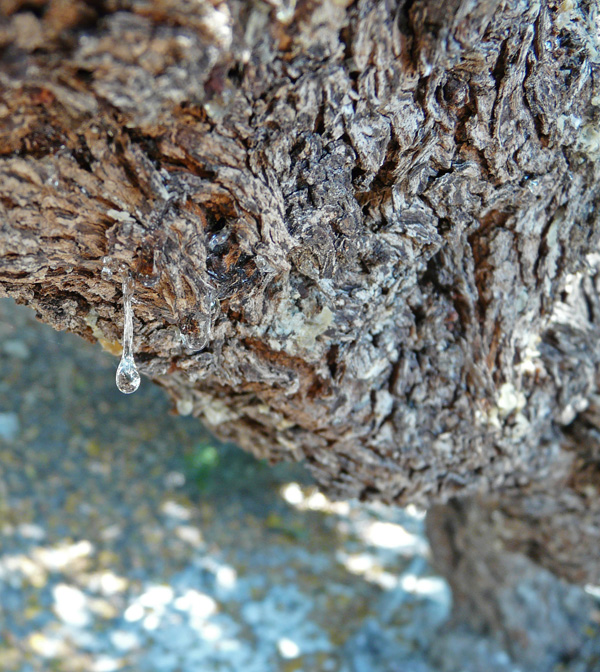38° 22.232’N 26° 8.560’E Sailing of the beaten track might bring you down from Samos to Chios, or maybe you arrive here while sailing down from the Skiros exploring the West Sporades! Chios is famous for Mastic, a unique branded product only found here.
On the Greek island of Chios, trees weep. These “tears” are piney-smelling, gummy mastic resin, which drips down from small slashes locals cut into the bark. Once wounded, the mastic trees release a sticky, gluey sap, which hardens into parchment-colored teardrops, then drop like small, fragrant pebbles to the ground, where harvesters collect them. Greeks use mastic as a flavoring for sweet and savory food, and as natural chewing gum. But arguably the most delicious use of mastic is also the most intoxicating: Distilled with sugar into a woodsy liqueur, mastic becomes Chios Mastiha.

Mastic tears
Floral and fresh, mastiha combines a spicy, syrupy sweetness with a touch of pine and slight alcoholic burn. Chios locals serve it mostly as a dessert liqueur, but outside the island, it’s made its way onto bar menus as an aperitif and a creative cocktail ingredient.
Contemporary Greek myth holds that the mastic trees began crying when the reigning Romans tortured a Christian martyr, but records of culinary and medicinal uses of Chios mastic go back well before the Romans. The ancient Greeks used it to treat digestive ailments. When the Romans did get their hands on it, they mixed the sap with egg, honey, wine, and pepper to make a spiced wine called conditum paradoxum. Later, Chios mastic was one of the most valuable products in the Ottoman Empire, and the Turkish name for Chios, Sakız Adası, literally means “gum island.” When the Ottomans brutally cracked down on the Greek independence movement in the 1822 Chios Massacre, they spared the residents of mastic-producing villages so production could continue.

A single drop of mastic hangs from the underside of this branch on a mastic tree. | wiki
Today, groves of mastic trees, their trunks Van Gogh–twisted and their leaves silver-green against the Mediterranean sky, grow across the Greek islands. But only the trees of southern Chios produce the coveted resin. This is why the 24 villages of the southern part of the island are known as mastichochoria, meaning “mastic villages.” Since 1992, mastiha has enjoyed Protected Designation of Origin status from the European Union, a certification the EU gives to products which must be made in a particular region to be authentic, in this case, in the mastichochoria. One taste of this liqueur, and you, too, may make like Chios’s mastic trees and cry with joy.
Need to Know
Genuine Chios mastiha must come from Chios itself, and there’s no better place to taste it then on its grassy hills, surrounded by the sea and by the sweet, breeze-born scent of sun-warmed sap. Those who can’t make the trip to Greece, however, can find genuine mastiha in good liquor stores. Look for the PDO label to guarantee authenticity.
Source: Atlas Obscura – Foods

